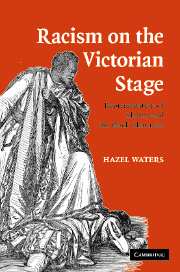Book contents
- Frontmatter
- Contents
- List of illustrations
- Acknowledgements
- Introduction
- 1 From vengeance to sentiment
- 2 The beginning of the end for the black avenger
- 3 Ira Aldridge and the battlefield of race
- 4 The comic and the grotesque: the American influence
- 5 The consolidation of the black grotesque
- 6 Slavery freed from the constraint of blackness
- 7 Uncle Tom – moral high ground or low comedy?
- Afterword
- Notes
- Bibliography
- Index
7 - Uncle Tom – moral high ground or low comedy?
Published online by Cambridge University Press: 22 September 2009
- Frontmatter
- Contents
- List of illustrations
- Acknowledgements
- Introduction
- 1 From vengeance to sentiment
- 2 The beginning of the end for the black avenger
- 3 Ira Aldridge and the battlefield of race
- 4 The comic and the grotesque: the American influence
- 5 The consolidation of the black grotesque
- 6 Slavery freed from the constraint of blackness
- 7 Uncle Tom – moral high ground or low comedy?
- Afterword
- Notes
- Bibliography
- Index
Summary
In tracing the development of the mulatto character as a replacement for the fearsome black character of an earlier period or as a figure who can evoke the injustice and degradation of slavery, I have left to the last consideration of one of the crucial staging posts on that journey. Harriet Beecher Stowe's novel Uncle Tom's Cabin (1852) was a major cultural phenomenon of the mid-nineteenth century; it was used in popular drama as a summation of all that had gone before and as a validation of the role of the light-skinned character in relation to slavery. Yet Uncle Tom's Cabin could have led to a different approach, had not the Jim Crow figure so completely colonised the popular imagination. In that sense, ‘Uncle Tom’ stands at a crossroads. That he, together with Jim Crow and Topsy, are still instantly and generally recognised names, loaded with significance, while the novel's (light-skinned) George and Eliza Harris are not, is suggestive of the continuity of the racialised cultural climate into which they (and we) were born. It is suggestive, too, of the line of development that can be traced from Crow through to Tom. As I have shown, Crow flourished most intensely on the stage from 1836 to the early 1840s, with another resurgence in the mid- to late 1840s – by which time he had escaped into popular entertainment generally, in minstrelsy and blackface.
- Type
- Chapter
- Information
- Racism on the Victorian StageRepresentation of Slavery and the Black Character, pp. 155 - 185Publisher: Cambridge University PressPrint publication year: 2007



